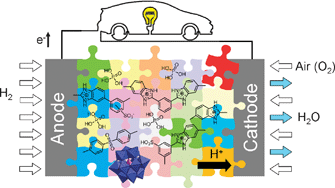Proton-conducting membranes based on benzimidazolepolymers for high-temperature PEMfuelcells. A chemical quest
Abstract
The development of high-temperature

* Corresponding authors
a
Centro de Investigación en Nanociencia y Nanotecnología, CIN2 (CSIC-ICN), Campus UAB, E-08193 Bellaterra (Barcelona), Spain
E-mail:
pedro.gomez@cin2.es
b Universidad Autónoma de Nuevo León, San Nicolás de los Garza Nuevo León 66450, México
The development of high-temperature

 Please wait while we load your content...
Something went wrong. Try again?
Please wait while we load your content...
Something went wrong. Try again?
J. A. Asensio, E. M. Sánchez and P. Gómez-Romero, Chem. Soc. Rev., 2010, 39, 3210 DOI: 10.1039/B922650H
To request permission to reproduce material from this article, please go to the Copyright Clearance Center request page.
If you are an author contributing to an RSC publication, you do not need to request permission provided correct acknowledgement is given.
If you are the author of this article, you do not need to request permission to reproduce figures and diagrams provided correct acknowledgement is given. If you want to reproduce the whole article in a third-party publication (excluding your thesis/dissertation for which permission is not required) please go to the Copyright Clearance Center request page.
Read more about how to correctly acknowledge RSC content.
 Fetching data from CrossRef.
Fetching data from CrossRef.
This may take some time to load.
Loading related content
